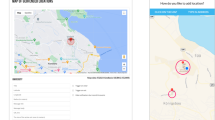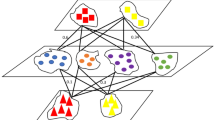Abstract
Location-based services (LBS) belong to one of the most popular types of services today. However, a recurring issue is that most of the content in LBS has to be created from scratch and needs to be explicitly tagged to locations, which makes existing Web content not directly usable for LBS. In this paper, we aim at making Web sites location-aware and feed this information to LBS. Our approach toward location-aware Web is threefold: First, we present a location extraction method: SALT. It receives Web sites as input and equips them with location tags. Compared to other approaches, SALT is capable of extracting locations with a precision up to the street level. Performance evaluations further show high applicability for practice. Second, we present three applications for SALT: Webnear.me, Local Browsing and Local Facebook. Webnear.me offers location-aware Web surfing through a mobile Web site and a smartphone app. Local Browsing adds the feature to browse by nearby tags, extracted from Web sites delivered by SALT. Local Facebook extends location tagging to social networks, allowing to run SALT on one’s own and one’s friends’ timeline. Finally, we evaluate SALT for technology acceptance of Webnear.me through a formative user study. Through real user data, collected during a 3 months pilot field deployment of Webnear.me, we assess whether SALT is a proper instance of “location of a Web site”.










Similar content being viewed by others
References
Opera standards for geocoding (2009) Location-based publishing and services. http://dev.opera.com/articles/view/location-based-publishing-and-services/
Gartner identifies 10 consumer mobile applications to watch in 2012 (2010). http://www.gartner.com/it/page.jsp?id=1544815
Agichtein E, Brill E, Dumais S (2006) Improving web search ranking by incorporating user behavior information. In: proceedings of the 29th annual international ACM SIGIR conference on research and development in information retrieval, SIGIR ’06, pp 19–26 ACM, New York, NY, USA. doi:10.1145/1148170.1148177
Aho AV, Corasick MJ (1975) Efficient string matching: an aid to bibliographic search. Commun ACM 18(6):333–340
Odon de Alencar R, Davis Jr C, Gonçalves M (2010) Geographical classification of documents using evidence from wikipedia. In: proceedings of the 6th Workshop on geographic information retrieval, p 12. ACM
Amitay E, Har’El N, Sivan R, Soffer A (2004) Web-a-where: geotagging web content. In: proceedings of the 27th annual international ACM SIGIR conference onresearch and development in information retrieval, pp 273–280. ACM
Anastácio I, Martins B, Calado P (2010) Using the geographic scopes of web documents for contextual advertising. In: proceedings of the 6th workshop on geographic information retrieval, p 18. ACM
Dao D, Rizos C, Wang J (2002) Location-based services: technical and business issues. Gps Solut 6(3):169–178
Davis F (1989) Perceived usefulness, perceived ease of use, and user acceptance of information technology. MIS Q, pp 319–340
Hess B, Gasimov A, Sutanto J (2011) A universal approach that makes legacy online content location-based. In: proceedings of the 10th international conference on mobile and ubiquitous multimedia, pp 127–133. ACM
Hess B, Magagna F, Sutanto J (2012) Discovering the web by location with webnear.me. In: proceedings of the 2012 ACM conference on ubiquitous computing, UbiComp ’12, pp 538–538. ACM, New York, NY, USA. doi:10.1145/2370216.2370298
Hill L (2000) Core elements of digital gazetteers: placenames, categories, and footprints. Res Adv Technol Digit Libr pp 280–290
Lakhina A, Byers J, Crovella M, Matta I (2003) On the geographic location of internet resources. Sel Areas Commun IEEE J 21(6):934–948
Leveling J, Hartrumpf S, Veiel D (2006) Using semantic networks for geographic information retrieval. In: Peters C et al. (eds) Accessing multilingual information repositories, pp 977–986. Springer, Berlin. http://link.springer.com/chapter/10.1007%2F11878773_109
Lieberman M, Samet H, Sankaranayananan J (2010) Geotagging: using proximity, sibling, and prominence clues to understand comma groups. In: proceedings of the 6th workshop on geographic information retrieval, p 6. ACM
Magagna F, Hess B, Sutanto J (2012) Building location-aware web with salt and webnear.me. Procedia Comput Sci 10:601–608
Markowetz A, Chen Y, Suel T, Long X, Seeger B (2005) Design and implementation of a geographic search engine. In: 8th international workshop on the web and databases (WebDB)
McCurley KS (2001) Geospatial mapping and navigation of the web. In: proceedings of the 10th international conference on World Wide Web, pp 221–229. ACM, Hong Kong. doi:10.1145/371920.372056
Morimoto Y, Aono M, Houle M, McCurley K (2003) Extracting spatial knowledge from the web. In: applications and the internet, 2003. Proceedings. 2003 Symposium on, pp 326–333. IEEE
Qin T, Xiao R, Fang L, Xie X, Zhang L (2010) An efficient location extraction algorithm by leveraging web contextual information. In: proceedings of the 18th SIGSPATIAL international conference on advances in geographic information systems, pp 53–60. ACM
Quercini G, Samet H, Sankaranarayanan J, Lieberman M (2010) Determining the spatial reader scopes of news sources using local lexicons. In: proceedings of the 18th SIGSPATIAL international conference on advances in geographic information systems, pp 43–52. ACM
Teevan J, Dumais ST, Horvitz E (2005) Personalizing search via automated analysis of interests and activities. In: proceedings of the 28th annual international ACM SIGIR conference on research and development in information retrieval, SIGIR ’05, pp 449–456. ACM, New York, NY, USA. doi:10.1145/1076034.1076111
Teevan J, Karlson A, Amini S, Brush AJB, Krumm J (2011) Understanding the importance of location, time, and people in mobile local search behavior. In: proceedings of the 13th international conference on human computer interaction with mobile devices and services, MobileHCI ’11, pp 77–80. ACM, New York, NY, USA. doi:10.1145/2037373.2037386
Tobin R, Grover C, Byrne K, Reid J, Walsh J (2010) Evaluation of georeferencing. In: proceedings of the 6th workshop on geographic information retrieval, p 7. ACM
Tseng V, Lin K (2006) Efficient mining and prediction of user behavior patterns in mobile web systems. Inf Softw technol 48(6):357–369
Virrantaus K, Markkula J, Garmash A, Terziyan V, Veijalainen J, Katanosov A, Tirri H (2001) Developing gis-supported location-based services. In: web information systems engineering. Proceedings of the second international conference on, vol 2, pp 66–75. IEEE
Zubizarreta Á, de la Fuente P, Cantera J, Arias M, Cabrero J, García G, Llamas C, Vegas J (2009) Extracting geographic context from the web: georeferencing in mymose. In: Boughanem M et al (eds) Advances in information retrieval, Lecture notes in Computer Science, vol 5478. Springer, Berlin, pp 554–561
Acknowledgments
The authors would like to thank Sebastian Wendland, Samuel Zihlmann and Dominik Bucher for the design and implementation of the Local Browsing application, as well as Thomas Bürli and Benjamin de Capitani for implementing a prototype of SALT. Further the authors thank Mihai Grigore for his help in proofreading the manuscript.
Author information
Authors and Affiliations
Corresponding author
Additional information
This paper is an extended and revised version of [16].
Rights and permissions
About this article
Cite this article
Hess, B., Magagna, F. & Sutanto, J. Toward location-aware Web: extraction method, applications and evaluation. Pers Ubiquit Comput 18, 1047–1060 (2014). https://doi.org/10.1007/s00779-013-0718-3
Received:
Accepted:
Published:
Issue Date:
DOI: https://doi.org/10.1007/s00779-013-0718-3




